Intel’s Core i5-655K & Core i7-875K: Overclocked and Analyzed
by Rajinder Gill on May 28, 2010 5:00 AM ESTTestbed Setup
|
Testbed Setup Overclocking / Benchmark Testbed |
|
|
Processors Used: |
Intel i7-875K ES CPU, 2.93GHz, 8 Threads, 8MB Cache Intel i5-750 Retail, 2.66GHz, 4 Threads, 8MB Cache Intel i5-655K ES CPU, 3.20GHz, 2 Cores 4 Threads, 4MB Cache Intel i5-661 ES CPU, 3.33GHz, 2 Cores 4 Threads, 4MB Cache Intel i3-540 Retail, 3.06GHz, 2 Cores 4 Threads, 4MB Cache |
| CPU Voltage | Various |
| Cooling | Intel air cooler, Heatkiller 3.0 waterblock, ThermoChill PA120.2 radiator and DDC Ultra pump (with Petra top). 1/2" ID tubing for watercooling. |
| Power Supply | Corsair HX950 |
| Memory |
Corsair Dominator GT 8-8-8-24 2200MHz 4GB kit (X2 for 8GB) |
| Memory Settings | 8-8-8-24 - 1T |
| Video Cards | MSI 275 Lightning (stock clocks) |
| Video Drivers | nVidia 195.62 WHQL |
| Hard Drive |
Western Digital 7200RPM 1TB SATA 3/Gbps 32MB OCZ Vertex 120GB SSD |
| Optical Drives | Plextor PX-B900A, Toshiba SD-H802A |
| Case |
Open Test Bed - Dimastech Benching Station Lian-Li V2110 |
| Operating System | Windows 7 64-bit |
| . | |
EVGA’s Classified motherboard was used for all of the overclocking and power consumption plots. We used a DC clamp meter directly on the EPS 12V power line to monitor current draw to VCC and VTT. Fortunately, we happen to know the approximate efficiency curve of the Volterra VRM so have taken the time to account for the switching losses in all figures shown.
Corsair’s Dominator GT 2200MHz kit was used at CAS 8-8-8-24 timings from DDR-3 1333MHz ~ DDR3 1820MHz. Not exactly tight for this kit, but representative of the memory timings many users will run using affordable memory kits on these processors (given the nature of the Clarkdale IMC).
For comparative purposes, all components used were exactly the same throughout our testing. All memory timings and bus frequencies were matched up as needed (unless specified otherwise).
Clarkdale i5-655K Overclocking
We’ll start off with the basics. First off, the maximum overclock using stock voltages:
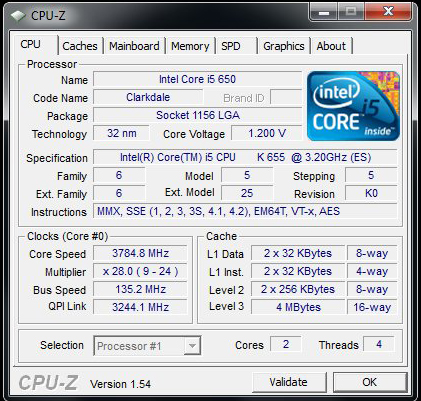
Next up, maximum stable overclocks:
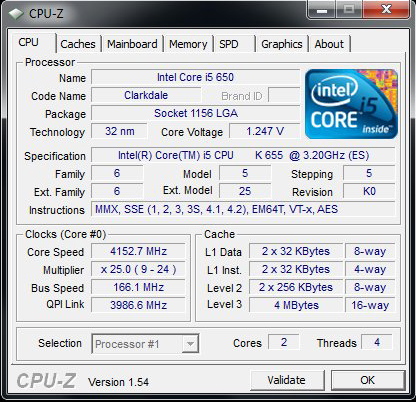
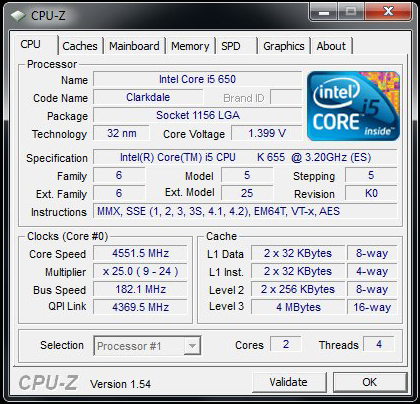
We’re often criticized for being a little brief and thin on overclocking results for our processor launch articles so we’re going to break things down a little further today and take a look at sensible operating points and compare the power curves of different processors.
VID, VCC & Relative Frequency Scaling
First up, let’s take a look at the stock voltages programmed by Intel (VID) for each processor on test today, and the required voltage under full Linpack load at stock frequency and 4.55GHz.
Do note, that actual load voltages will vary from board to board depending upon loadline resistance, Voffset and Vdroop. For the uninitiated, Voffset is difference between the applied voltage and the actual idle state voltage, while Vdroop is the level of voltage sag between idle and full load processor states. These safety margins are necessary to ensure that the real time voltage level (VCC), does not breach the applied VID for extensive periods or by excessive levels (acceptable overshoot margins are stipulated in the Intel white papers). Further explanation of these design principals is provided here.
| Processor | Stock Frequency | Turbo Mode | Stock VID | Stock VCC (Load) | VCC @ ~4.55GHz (Load)* |
| i3-540 | 3.06GHz | N/A | 1.0500V | 1.029V | 1.323V |
| i5-655K | 3.20GHz | 3.46GHz | 1.2125V | 1.190V | 1.378V |
| i5-661 | 3.33GHz | 3.6GHz | 1.1625V | 1.143V | 1.306V |
*Overclocked voltage requirements using water-cooling.
At first glance, the i5-661 stands out for having a relatively low stock VID in relation to its maximum single-threaded Turbo mode speed of 3.6GHz. That’s 160MHz higher than the i5-655K with a small reduction in voltage. Not only that, but it manages to reach 4.55GHz using the lowest VCC of these three test samples.
Here’s a graphical representation of how each processor scales frequency versus voltage, normalized to each part's stock VCC:
Of course, this is but a mere portion of the story, what we’re interested in is the power consumption of each processor at equivalent frequencies and how that has an impact on frequency scaling given various forms of cooling.


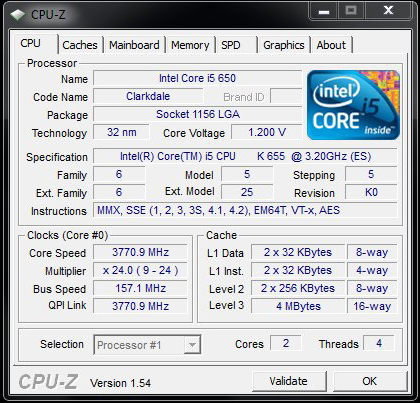
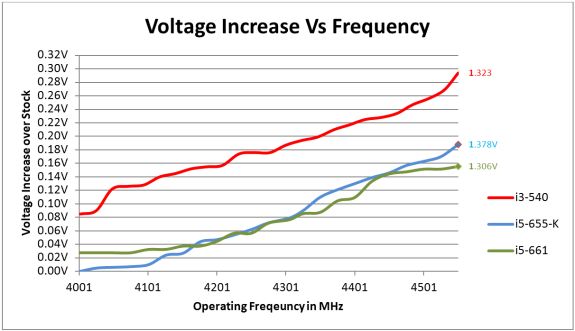








51 Comments
View All Comments
wavetrex - Friday, May 28, 2010 - link
In the table it sais $284 for the 980X, that MUST be a mistake!mianmian - Friday, May 28, 2010 - link
In a previous Anandtech aritical, it was $999, maybe it is $824 nowTexpat - Friday, May 28, 2010 - link
I think the price for the 980x might be wrong. $1,000 would be closer tot he truth.ltcommanderdata - Friday, May 28, 2010 - link
I'm really pleasantly surprised that the 2.93GHz Core i7 875K at $342 is cheaper yet has more features than the 2.93GHz Core i7 870 at $562. Although I'm guessing that's only temporary as the upcoming 3.06GHz Core i7 880 will probably take over the $562 price point, with the Core i7 870 dropping down to $284 and the Core i7 860 being phased out. There's also a Core i5 760 to replace the Core i5 750.DrMrLordX - Friday, May 28, 2010 - link
You guys really busted out the big guns with the dual-stage cascade! Please do this more often when overclocking. I would love to see a C3 Propus at -100C (or a Thuban).jleach1 - Friday, May 28, 2010 - link
On the second page, i believe in the 'test rig' table the proc is listed as a i5-870 instead of the i7-870Rajinder Gill - Friday, May 28, 2010 - link
Thanks - fixed!GeorgeH - Friday, May 28, 2010 - link
"it’s full of talk about voltages and harps on about overclocking"No need to be shy about that - Anandtech is bookmarked because of awesome articles and analyses like this one.
FlanK3r - Friday, May 28, 2010 - link
not bad, my x6 1090T is full stable 4300MHz 2800MHz NB with aircooling ,-)...for games and benchmarks 4400-4450 MHz :)AstroGuardian - Friday, May 28, 2010 - link
Guys, i think you should not hurry to release articles instead of taking them slow and sure. Many typos especially in the graphs.i3-530 vs i5-540